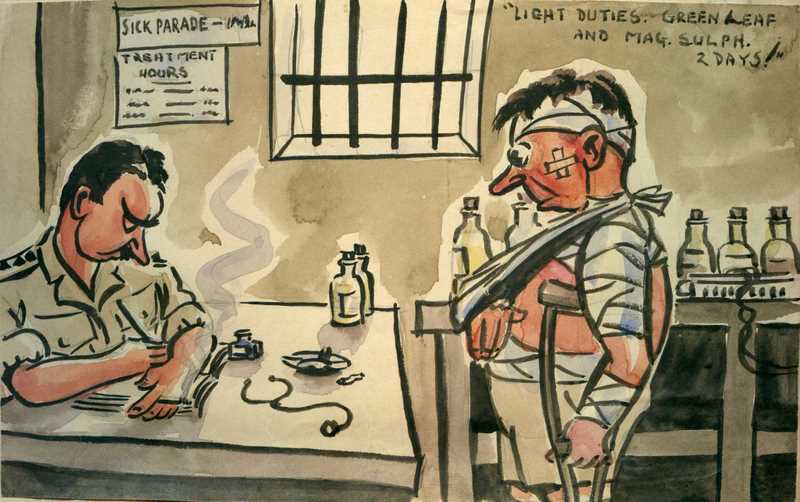Sick Parade ‘Light Duties. Green Leaf and Mag. Sulph. 2 Days!!’
Light Duties. Green Leaf and Mag.Sulph. 2 days!!
This man appears before the Medical Officer with possible fractured scull; fractured left arm; fracture ribs; fractured left leg; facial injuries; injuries to right shoulder; right arm; and right wrist and given just 2 days off on light duties!! He is also given a prescription for green leaf and mag sulphur, indicating he probably had dysentery also. I wonder if they ‘bulk billed’??
Perhaps Des was making a comment on how tough the men were. Perhaps it’s an indication that if the Medical Officer didn’t provide 85% of the work force ‘fit’, then he would be punished. When one considers many had limbs removed or were dying of starvation and a whole list of tropical diseases including cholera, malaria, dysentery, typhus and beri beri perhaps Des is saying ‘well, son, you are lucky you are alive’. One can just ponder the background to this watercolour painting.
Most horrifying of all was the brutal treatment experienced by the prisoners at the hands of their Japanese and Korean captors.
The guards were not disciplined by their superiors and were free to beat the soldiers with whatever implements they had at hand, including rifle butts, shovels, bamboo poles and crowbars.
The prisoners were hit anywhere and everywhere – in the groin, on ulcers and wounds, broken bones, faces, necks, backs.
They were beaten for often minor infractions.
The Japanese guards often punished the sick and injured as a deterrent to falling ill in the first place.
They set a cracking pace by working prisoners in shifts of 24 hours on and off. Men who were sick with tropical diseases were forced to work as long and as hard as healthy men.
Magnesium sulphateis a chemical commonly referred to as Epsom salt. It was used for treating dysentery and diarrhoea. It was also effective against all ‘worms’ such as roundworms, hookworms, thread worms, tapeworms etc.
“And after ‘breakfast’, the parade to the so – called ‘hospital’ of those who were optimistic enough to think that by parading they might get medical attentions. Admittedly, for this purpose, there was an M.O. But he had at his disposal no drugs, no dressings, only a few pairs of forceps and an old stethoscope. He had to cure gangrenous wounds, amoebic and bacillary dysentery, incipient avitaminosis, malaria, dengue, and soon scabies. In those early days there seemed to be nothing that could he could do – but one sill paraded, if only for the cold comfort of hearing him say so.”
Source: The Naked Island by Russell Braddon; 1955 edition Pan Books Ltd, Pg117
‘The doctors and nursing staff managed t have a section of the building (jail) set up as a hospital and the doctors even held clinics in their cells.’
Source: Diary of a Girl in Changi by Sheila Allan; 4th edition 2010, Griffin Press, pg 242

